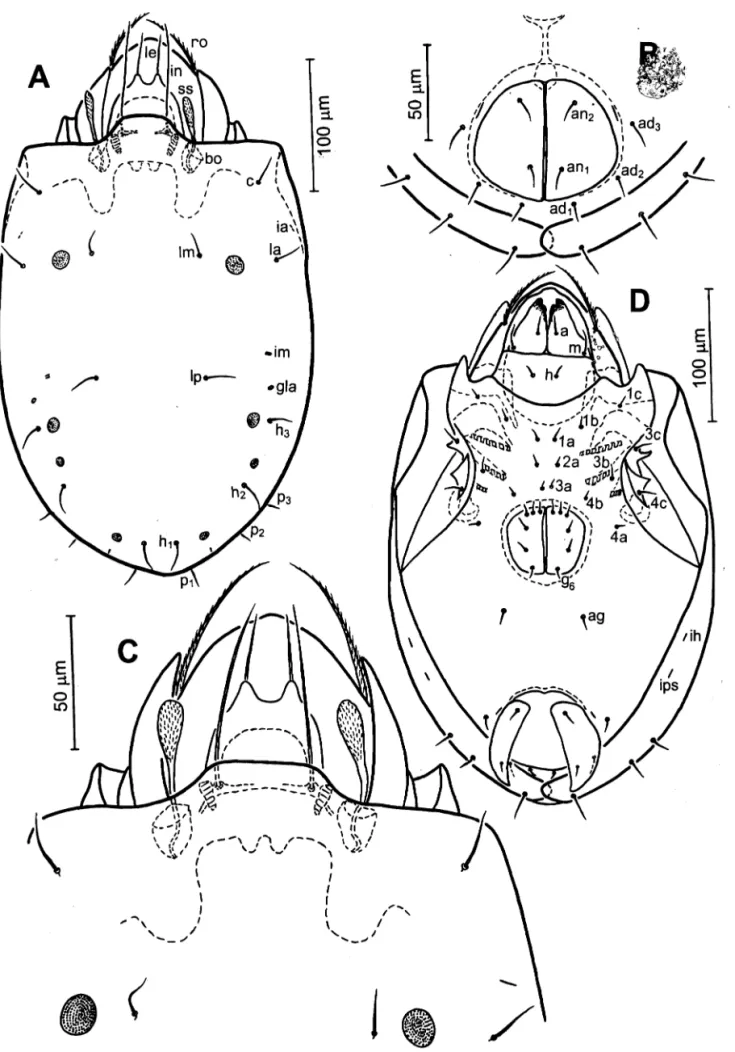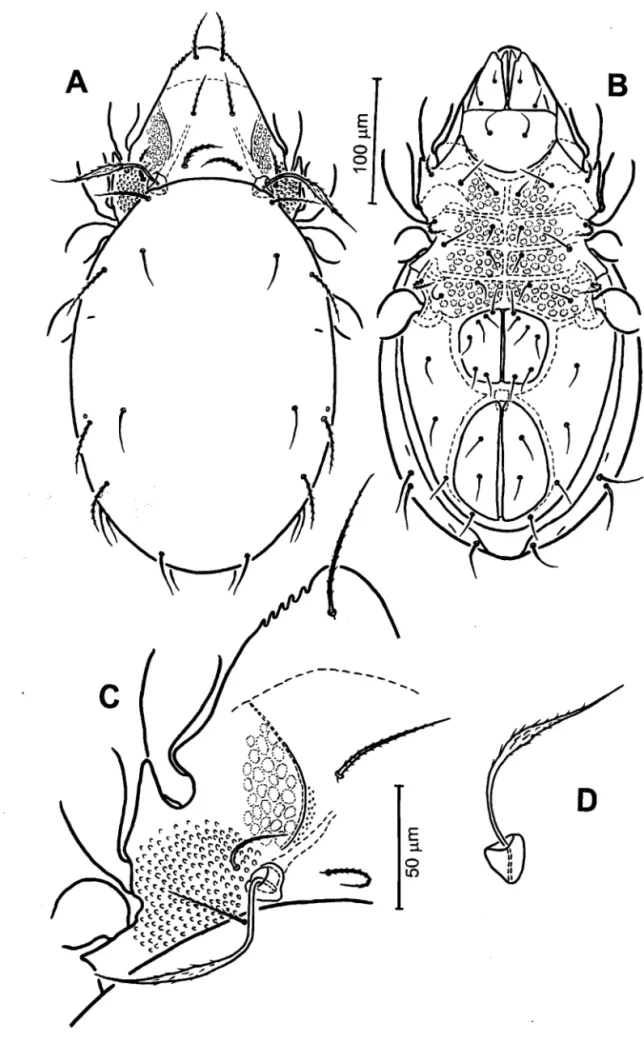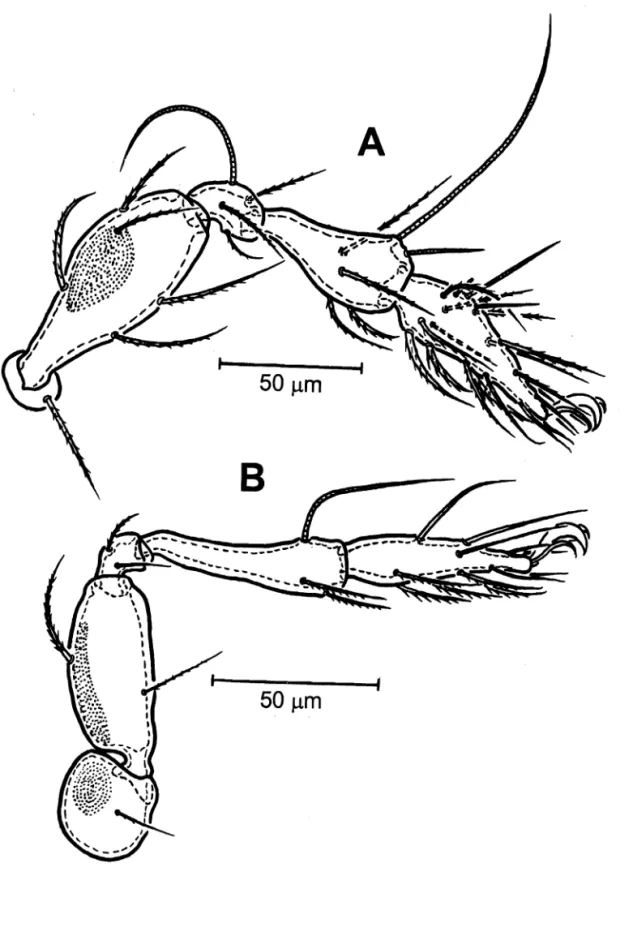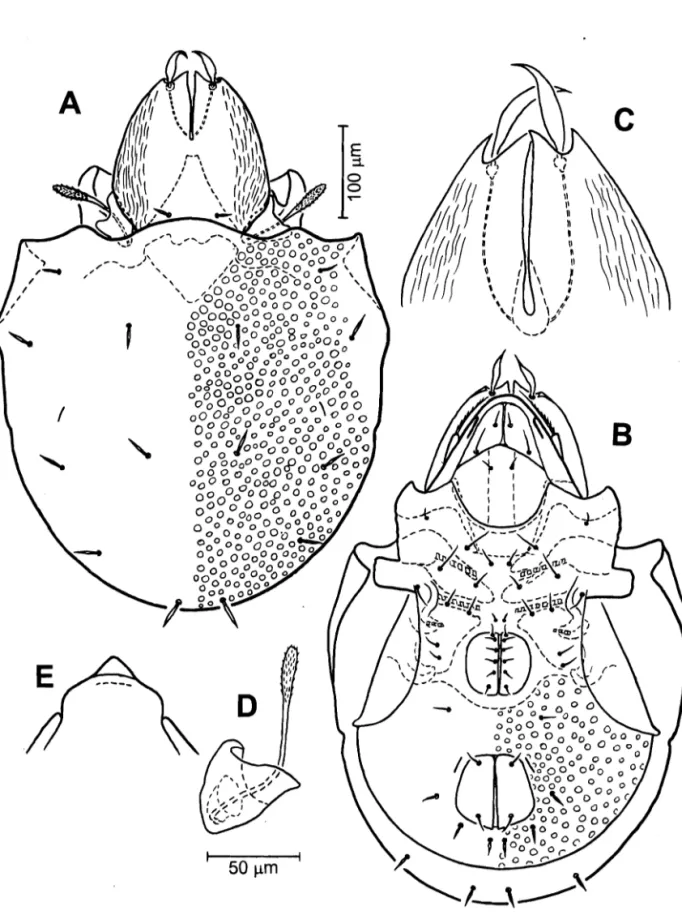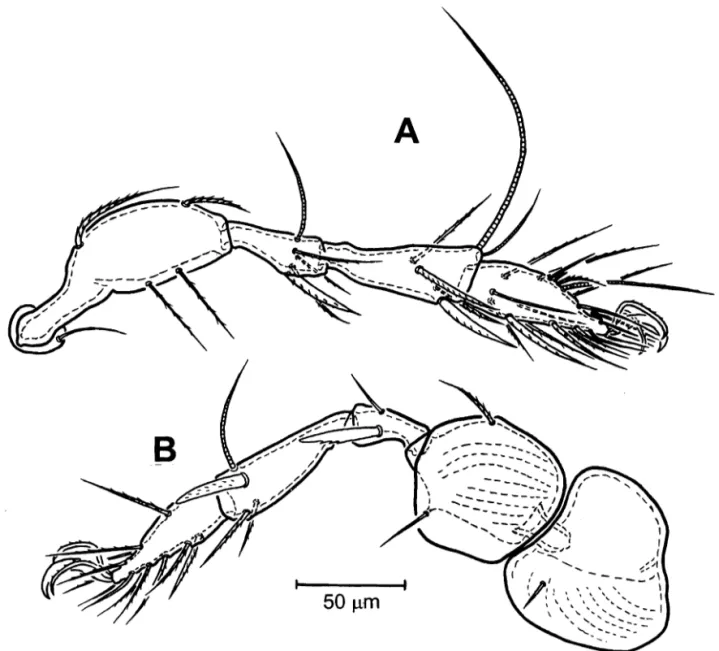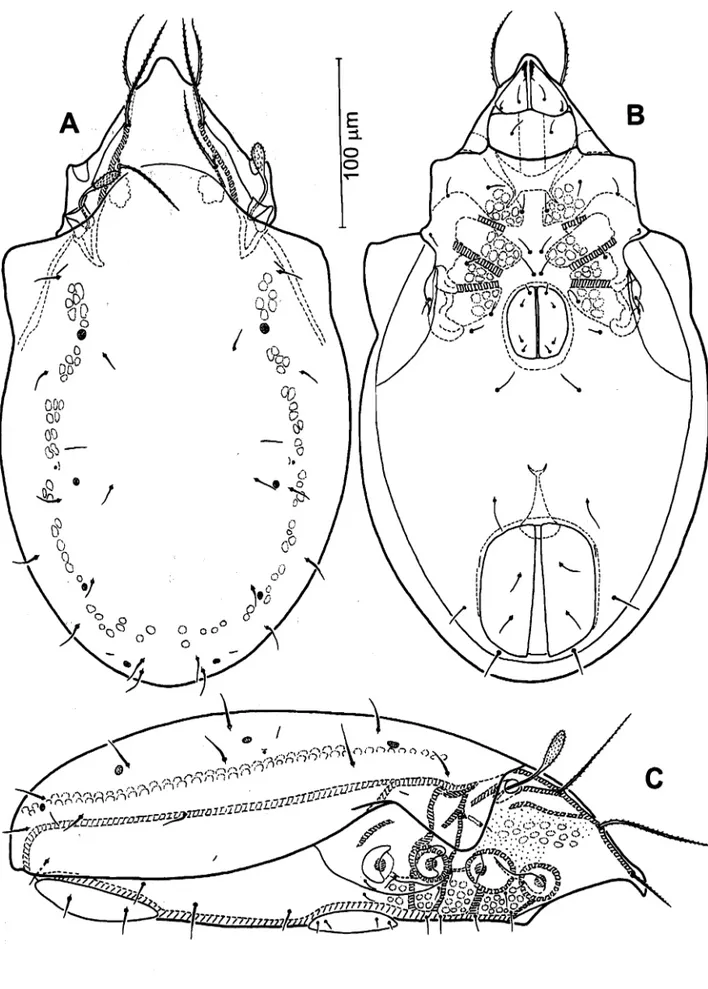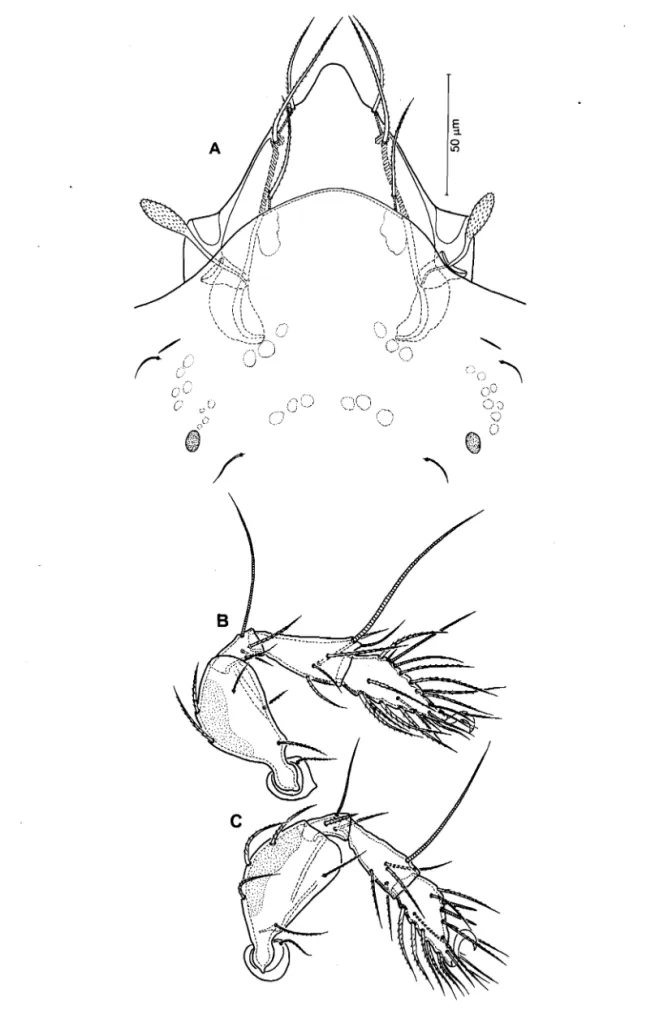Mongolian Journal ofBiologica1 Sciences 2003 Vol. / ( I ) : 3-19
Four Species of Oribatid Mites (Acari: Oribatida) from Central and
Southern Mongolia, with Notes on the Genera
Montizetes
and
Zachvatkinibates
Badamdorj Bayartogtokh
Faculty of Biology, National University of Mongolia, Ulaanbaatar 210646, Mongolia e-mail: bayartogtokh@num.edu.mn
Abstract
In the present work four species of oribatid mites from central and southern parts of Mongolia are studied, and two of them, namely Zachvatkinibates mongolicus sp. nov. and Montizetes serratus sp. nov. are described as new to science. Two other species, Kunstella foveolata Krivolutsky and Liebstadia pannonica(Wil1mann) are recorded as new to the fauna of Mongolia, and the latter species is reported for the first time from Asia. Description of new and redescription of known species, and data on geographic distribution of known species are given. Anew combination, Montizetes tianshanensis (Wen) comb. nov. is proposed. Identification keys to the world species of the genera Zachvatkinibates and Montizetes are provided.
Key words: Acari, Oribatida, Zachvatkinibates, Montizetes, Kunstella, Liebstadia, Mongolia
Introduction
The study on biodiversity of oribatid mites of Mongolia is relatively recent and is the subject of ongoing research as part of biodiversity assessments in various ecosystems of the country. Among soil microarthropods, the oribatid mites are one of the numerically dominant groups in different natural habitats, .and their description should facilitate further ecological and biogeographical studies on this fauna.
In the course of taxonomic and ecological studies of oribatid mites of Mongolia, several interesting species belonging to the genera Zachvatkinibates Shaldybina, Montizetes Kunst, Kunstella Krivolutsky and Liebstadia Oudemans are found from central and southern parts of the country.
The first genus studied here, Zachvatkinibates has been represented in Mongolia by single species, while two species ofthe second genus, Montizetes have been recorded previously from Mongolia (Balogh & Mahunka, 1965; Bayartogtokh, 1998; Bayartogtokh & Aoki, 1998).
The genus Kunstella is monotypical, and until the present moment it has been known to be distributed only in Mt. Gorny Altai, Southern Siberian region of Russia (Krivolutsky, 1974, 1995). However, the type species, K. foveolata is
found in the desert habitats of southern Mongolia, which is the second distributional record for this genus.
The last genus, Liebstadia is rather rich in Mongolia in terms of species richness, representing by four species (Bayartogtokh, 2001). The author adds one more species, Liebstadiapannonica, not only to the fauna of Mongolia, but also in Asia, which has been known before only from Europe.
Materials and Methods
The present work is based on materials collected mostly by two our graduate students. Part of the material was collected from mountains Zuun Saikhan and Dund Saikhan in Gobi Gurvan Saikhan Nature Reserve area in the South Gobi Province, during the joint research conducting by the Faculty of Biology of the National University of Mongolia and the Faculty of Geography of the Philipps University of Marburg, Germany.
The other part of the study materials was collected from semidesert habitats in Mt. Ikh Gazryn Chuluu in the Middle Gobi Province, during field trip initiated by the Faculty of Biology, National University of Mongolia. In addition, some materials were collected from Mt. Bogdkhan, located close to the capital city Ulaanbaatar, and Mt. Khustai in Central Province.
4
Bayartogtokh. Four species of oribatid mitesfrom Mongolia The type locality and habitat characterization for each species are given in the respective "material examined" sections. All specimens used for this study are represented as adults.The morphological terminology used in this paper is based on that (with a few modifications) generally developed by F. Grandjean (see TravC and Vachon, 1975 for references).
Body length is measured in lateral view, from the tip of rostrum to the posterior edge of notogaster. Notogastral length is measured in lateral aspect, from the anterior to the posterior edge. Notogastral width refers to the maximum width in dorsal aspect. All measurements are given in micrometers (pm), and the average measurement values are given in parentheses after the range. The line drawings were made with the aid of a camera lucida attached to a compound microscope "PZO SK- 14".
Descriptions of Species
Zachvatkinibates mongolicus sp. nov.
(Fig. 1)
Diagnosis. Medium in size; rostrum rounded; rostral setae long, distinctly barbed; lamellae narrow; lamellar cusps short, narrow; translamella wide; lamellar setae medium long, thin, smooth; interlamellar setae long, but thin, smooth; sensilli with minutely barbed elongate oval or club-shaped head; tutoria wide, distinctly widened in its posterior part, but narrowed anteriorly, distal end without tooth; notogastral setae medium long; pteromorphae smooth, bent downwards; posterior notogastral tectum with overlapping lobes.
Measurements. Six specimens were measured: body length 360-372 (366) pm; width of notogaster 207-232 (220) pm; length of notogaster 305-323 (313) pm.
Integument. Body color yellowish to reddish- brown. Cerotegument thin, roughened by minute granules. Lateral region of podosoma with small, but distinct granules.
Prodorsum. Rostrum rounded in dorsal view, without lateral dens. Rostra1 setae (ro) inserted laterally, about 52-56 pm long, distinctly barbed, extending well beyond the tip of rostrum. Lamellae relatively narrow, converging anteriorly; lamellar cusps short, blunt at tip; translamella very wide. Lamellar setae (le) thin, smooth, about 17-20 pm in length, reaching to the tip of rostrum. Interlamellar setae (in) approximately 71-76 pm
long, thin, smooth, extending beyond tip of rostrum, inserted on small apophyses on transverse ridge underneath of anterior tectum of notogaster. Bothridia (bo) cup-shaped, completely covered by the anterior tectum of notogaster. Sensillii (ss) about 36-4 1 pm in length, minutely barbed, with relatively long elongate oval or club-shaped head and smooth narrow stalk. Tutoria wide, distinctly widened in its middle and posterior parts, but narrowed anteriorly, with distinct cusps distally, extending beyond the level of the insertion of rostral setae; distal end of tutorial cusps without tooth (Figs. 1 A & C).
Notogaster. Oval, longer than wide, ratio of length and width 1.4:l. Anterior tectum of notogaster moderate in size, its margin nearly straight. A pair of heavily sclerotized longitudinal ridges present on the anterior margin of notogaster (between two bothridia). Pteromorphs well developed, bent downwards, immovable, line of desclerotization absent. Notogastral setae moderately long, thin, smooth. Porose areas nearly circular to oval; Aa largest, while A, smaller than the former and A, and A, much smaller than others. Notogastral lyrifissures ia, im and ip well visible in dorsal view, while ih and ips visible in lateral or ventral views. Opisthosomal gland opening (gla) located posterolaterad of seta
Ip
in rather far distance (Fig. 1A). Posterior notogastral tectum with overlapping lobes (Figs. 1B & D).Gnathosoma. Subcapitulum without mental tectum; hypostomal setae a , h and m medium long, smooth. Anterior margin of rutellum strongly sclerotized, with a few blunt teeth (Fig. ID). Structure and setation of palps and chelicerae typical for genus.
Epimeral region. Surface of epimeral region smooth; apodemes apo.2, apo.sj and apo.3 well developed, aligned obliquely, almost parallel to each other. Apodeme apo. 3 much shorter than two formers. Epimeral setae medium long, smooth, all setae approximately equal in length. Circumpedal carina well developed, reaching to lateral margin of ventral plate. Discidium triangular, distinctly projected distally (Fig. 1 D).
Fig. 1. Zachvatkinibates mongolicus sp. nov. A: Dorsal aspect of idiosoma; B: Anal and adanal regions, showing posterior notogastral tectum; C: Prodorsum and anterior part of notogaster;
6; Bavartogtokh. Four species oforibatid mites from Al(ongo1ia to that between epimeral setae 4b-4b. Adanal lyrifissqre ( i a 4 small, situated adjacent and parallel to anterc 1. {era1 margin of anal aperture (Figs. 1B & D).
Legs. Tibia I with small, but distinct dorsodistal projection, tibiae 11-IV with relatively large dorsodistal projections. Structure and setation of legs typical for genus; formula of leg setation (including famulus): 1(1-5-3-4-20); I1 (1-5-3-4-15); I11 (2-3-1-3-1 5); IV (1-2-2-3-12); formula of solenidia: I (I -2-2); 11 (I- 1-2); I11 (1- 1-0); IV (0- 1 - 0).
Materialexamined. Holotype (female) and two paratypes (male and female), Ulaantolgoi area, Mt. Dund Saikhan, Gobi Gurvan Saikhan Mountains, District Bayandalai, South Gobi Province, semidesert, soil under Artemisia santolinifolia Turcz. & Bess., 26 July 2002, Col. Ts. Bolortuya; one paratype (female): Mt. Ikh Gazryn Chuluu, District Gurvansaikhan, Middle Gobi Province, semidesert, organic debris accumulated between rocks, 45"50'N, 107"l O'E, 1 8 June 2002, Col. D. Narangarvuu. The holotype and paratypes are deposited in the collection of the Department of Zoology, National University of Mongolia, Ulaanbaatar, Mongolia. All specimens are presewed in alcohol.
Remarks. The new species, Zahcvatkinibates mongolicus sp. nov. is easily distinguishable from most other known species of the genus by the very broad translamella, short lamellar cusps, very wide tutoria and the absence of line of desclerotization of pteromorphs. Among the known species of Zachvatkinibates, the Mongolian species, Z. latilanzellatus Bayartogtokh & Aoki, 1998 resemble the new species in the character of lamellae, lamellar cusps and sensilli. However, Z. mongolicus sp, nov. is clearly differs from the latter species in the I) posterior notogastral tectum with overlapping lobes as opposed to the not overlapping, but separated lobes of the posterior notogastral tectum in Z, latilamellatus; 2) absence of the line of desclerotization of pteromorphs as opposed to the presence of incomplete line of desclerotization in Z. latilamellatus; 3) much broad tutoria in comparison with narrow tutoria in Z. latilamellatus; 4) relatively long lamellar cusps as opposed to the almost indistinct cusps in Z latilamellatus, and 5) smooth lamellar and interlamellar setae as opposed to the minutely barbed setae in the compared species.
Two species, Z. tetrasklerosis and Z. eplphytos
described by Behan-Pelletier (1988,2001), known fromNorth America have immovable pteromorphs. However, both the species, Z. tetrasklerosis Behan- Pelletier and Z. epiphytos Behan-Pelletier are different from Z. mongolicus sp. nov. in the 1) relatively long and narrow lamellae and translamellae; 2) much narow tutoria; 3) relatively small anterior notogastral tectum; 4) thick and strongly barbed lamellar and interlamellar setae, and 5) different arrangement of notogastral setae, porose areas and lyrifissures.
Etymology. The specific name "mongolicus" refers to the name of country, which encompassing the type locality of this species.
Montizetes serratus sp. nov. (Figs. 2 & 3)
Diagnosis. Medium in size; tip of rostrum rounded, but its anterolateral margin with distinct serrations; costulae poorly developed, not reaching to the level ofthe insertion of lamellar setae; outside costulae on each side present a distinct longitudinal ridge, diverging anterolaterad; sensilli fusiform, sharply pointed distally and terminating in setiform prolongation; rostral, lamellar and interlamellar setae moderately long, finely barbed; exobothridial region tuberculated.
Measurements. In total 16 specimens were measured: body length 378-420 (393) pm; width 201-220 (21 0) pm; length of notogaster 256-286 (265) pm.
Integument. Body color yellowish brown. Surface of body and leg segments with relatively thin granular cerotegument. Distinctly tuberculated on exobothridial region, lateral part of prodorsum and around leg acetabula.
Mongolian Journal ofBiologica1 Sciences 2003 Vol. l(1) 7
8
Bayartogtokh. Four species oforibatid mites from MongoliaMongolian Journal ofBiological Sciences 2003 Vol. 1(1)
9
their bases. Interlamellar setae barbed, about 3 1- 35 ym in length. Exobothridial setae barbed, 30- 34 p n ~ long, slightly slender than other prodorsal setae. Bothridia directed anterolaterad, its posterior part concealed under anterior margin of notogaster. Sensilli 80-96 ym long, fusiform, sharply pointed distally and terminating in setiform prolongation. Swollen portion of sensilli roughened with sparse barbs. Exobothridial region tuberculated (Figs. 2A, C & D).
Notogaster. Oval, 1.5 times as long as wide, its anterior and posterior margins broadly rounded. A small humeral lobe slightly protruding on each side. Ten pairs ofnotogastral setae moderately long, seta c, la, h, and h, barbed, other notogastral setae thin and smooth. Lyrifissure im situated posterior to seta la, in far distance; opisthosomal gland opening gla situated just anterolaterad of seta h,. Lyrifissures ih and ips well visible in ventral view. Posteroventral end of notogaster distinctly narrowed. (Figs. 2A & B).
Gnathosoma. Infracapitular mentum slightly wider than long, without noticeable microtubercles. Hypostomal setae h, m and a medium long, thin, smooth (Fig. 2B). Chelicera relatively large, fixed and movable digits with few blunt teeth; setae cha and chb conspicuously barbed.
Epimeral region. Covered with round muscle sigillae. Coxisternal ridges I, 11, sj, 111 and IV well developed. Epimeral setal formula 3: 1 :3:3; most of epimeral setae fine, but setae Ic, 3c and 4c barbed; sctae I b and 3b distinctly longer than other epimeral setae.
Ano-genital region. Anal and genital apertures large, located close to each other. Six pairs of genital, one pair of aggenital, two pairs of anal and three pairs of adanal setae smooth, moderately long. Setae g,-g, situated close to anterior margin of genital plates, while g, and g, situated close to posterior margin. Distance between bases of aggenital setae nearly equal to that between ad,- ad,. Adanal lyrifissure iad located anterior to the level of anal setae an, and adjacent to lateral margins of anal plates.
Legs. All tarsi heterotridactylous, the median claw much thicker than the laterals; tibia1 with very long solenidion cp,, and short
cp,
inserted nearly in front of 9,. Femora I-IV and trochanters 111 and IV with large porose areas. Structure and setation of legs I and IV as shown in Figs. 3A & B.Material examined. Holotype (male) and four paratypes (one male and three females): Gorge
Chuluut, Mt. Bogdkhan, 18 km south-east from the city Ulaanbaatar, larch forest (Larix sibiricus), 14 October 2002, Col. D. Narangarvuu; ten paratypes (six males and four females): Gorge Shajin Khurakh, Mt. Bogdkhan, 24 k i south-east from the city Ulaanbaatar, larch forest (Larix sibiricus), 24 June 2002, Col. B. Bayartogtokh; five paratypes (three males and two females): Ulaantolgoi area, Mt. Dundsaikhan, Gobi Gurvan Saikhan Mountains, District Bayandalai, Province South Gobi, semidesert, soils under Juniferus sabina L.,
26 July 2002, Col. Ts. Bolortuya. The holotype and paratypes are preserved in the collection of the Department of Zoology, National University of Mongolia, Ulaanbaatar, Mongolia.
Remarks. Montizetes serratus sp. nov. is easily distinguishable from other species of the genus by the serrated anterolateral margin of rostrum, which being with five or six small teeth on both right and left sides. All other known species of Montizetes have smoothly rounded rostrum, and only the members of the genus Pantelozetes Grandjean show such structure. However, the species of the latter genus are monodactylous.
10 Bayartogtokh. Four species of oribatid mitesfrom Mong
differentiated from new species in the smooth notogastral setae la, h, and h,; different arrangement of notogastral setae, lyrifissures and opisthosomal gland openings and much larger body size.
Etymology. The specific name "serratus" refers to the serrated rostrum of the present species.
Kunstella foveolata Krivolutsky
(Figs. 4 & 5)
Kunstella foveolata Krivolutsky, 1974: 1883, fig. E.
Kunstella foveolata: Krivolutsky, 1975 : 3 3 0, fig. 824; 1995: 204; Golosova et al., 1983: 11; Krivolutsky et al., 1984: 1021; Karppinen et al., 1986: 91.
Diagnosis. Relatively large species; rostrum narrowed anteriorly and incised laterally; lamellae large, covering prodorsum except pedotectum I, fused medially, lateral margins with longitudinal striations; lamellar cusps large, nearly as long as basal part of lamellae, each cusp with large lateral and inner teeth; translamella narrow; lamellar setae moderately long, elongate leaf-shaped and sharply pointed distally; interlamellar setae short, smooth, widened medially and pointed distally; sensilli with minutely barbed elongate oval head; notogastral setae medium long, smooth, widened medially and pointed distally; notogaster and ventral plate foveate; lenticulus present; pteromorphae smooth, bent downwards, without line of desclerotization; adanal setae widened medially and pointed distally, other ventral setae thin.
Measurements. Six specimens were measured: body length 5 12-543 (524) pm; width of notogaster 335-342 (338) pm; length of notogaster 390-409 (396) pm.
Integument. Body color yellowish to dark- brown. Cerotegument fairly thick, microtuberculate over whole body and leg segments. Microtubercles forming distinct longitudinal striae on lateral parts of lamellae. Notogaster and ventral plate distinctly foveate.
Prodorsum. Rostrum narrowed anteriorly, incised laterally, which well visible after dissection or in ventral view (Fig. 4E). Rostra1 setae moderately long, distinctly barbed, reaching to the tip of rostrum, inserted ventro-laterally on distinct tubercles. Lamellae large, covering prodorsum except pedotectum I, fused medially, lateral margins with longitudinal striations. Lamellar cusps large,
nearly as long as basal part of lamellae, each cusp with large lateral and inner teeth. Translamella relatively narrow. Lamellar setae moderately long, elongate leaf-shaped and sharply pointed distally (Figs. 4A & C). Interlamellar setae short, smooth, widened medially and pointed distally. Exobothridial setae short, thin, smooth. Sensilli with minutely barbed elongate oval head and smooth narrow stalk. Bothridia large, partly covered by the anterior margin of notogaster (Figs. 4A & Dl.
Notogaster. Anterior margin wavy, anteromedian part slightly arched, but curved inward at the level of bothridia and laterad of pedotecta I; posterior margin broadly rounded; ratio of length and width 1.1 : 1. Surface of notogaster distinctly foveate; lenticulus present Pteromorphs well developed, bent downwards, immovable, line of desclerotization absent. Notogastral setae moderately long, smooth, widened medially and pointed distally. Notogastral lyrifissures im well
visible in dorsal view, while other lyrifissures not evident. (Fig. 4A).
Gnathosoma. Subcapitulum without mental tectum; hypostomal setae a, h and m medium long,
smooth.
Epimeral region. Surface of epimeral region smooth; apodemes apo.2, apo.sj and apo.3 well developed, two formers aligned obliquely, almost parallel to each other, while apo.3 oriented transversely and much shorter than two formers. Epimeral setae moderately long, thin, sn~ooth, all setae approximately equal in length. Setal formula 3-1-3-2, setaand 4c not evident, one ofthe examined specimens showed two setae on each side of epimeral region 2, but it seems to be abnormal character. Circumpedal carina well developed, reaching to lateral margin of ventral plate. Pedotecta
I and I1 large; lateral margins of ventral plate with a distinct angular projection on each side (Fig. 4B). Ano-genital region. Anal aperture being slightly larger than genital one. Genital setae short, thin, approximately same in length, all setae inserted along inner margin of genital plates. Aggenital setae short, thin, distance between bases of aggenital setae slightly shorter than that between adanal setae. Anal setae slightly longer than genital setae, thin, smooth. Adanal setae widened medially, but pointed distally, nearly as long as anal setae. Adanal lyrifissure relatively large, situated adjacent and parallel to anterolateral margin of anal aperture (Fig. 4B).
Mongolian Journal of Biological Sciences 2003 Vol. I ( I )
11
12
Bayartogtokh. Four species of oribatid mites from MongoliaFig. 5. Kunstella foveolata Krivolutsky, 1974. A: Leg I (right, antiaxial view); B: Leg IV (right, antiaxial view).
antiaxial and paraxial claws with distinct serrations. Femur and trochanter IV with longitudinal striations. Structure and setation of legs I and IV as shown in Fig. 5. Formula of leg setation (including famulus): I (1-5-3-4-19); I1 (1-5-3-4-1 5); I11 (2-3- 1-3- 15); IV (1-2-2-3-12); formula of solenidia: I (1 -2-2); I1 (1 - 1-2); I11 (1 - 1-0); 1 v (0- 1-01.
Material examined. One male and three females: Modot Shivert area, Mt. Zuun Saikhan, Gobi Gurvan Saikhan Mountains, District Khankhongor, South Gobi Province, semidesert, soils under birch grove (Betula fusca Pall. & Georgi.) with Rebis rubrum L and Salix sp., 16 July 2002, Col. Ts. Bolortuya.
Remarks. Certain character states of the specimens examined here correspond well with those of the type specimens from South Siberia,
described by Krivolutsky (1974). The body size of the specimens studied here was relatively smaller than that of the type material from Siberia. Some supplementary characters are provided in the present redescription.
Known distribution. Russia: South Siberia, Mt. Gorny Altai (Krivolutsky, 1974, 1975, 1995; Golosova et al., 1983; Krivolutsky et al., 1984; Karppinen et al., 1986), and Mongolia (present data).
Liebstadia pannonica (Willmann)
(Figs. 6 & 7)
Protoribatespannonicus Willmann, 195 1 : 1 65, fig. 35.
Mongolian Journal of Biological Sciences 2003 Vol. I ( I )
3; Sellnick, 1960: 69; Krivolutsky, 1962: 58; Mahunka & Mahunka-Papp, 2000: 47. Xylobates variabilis (Rajski): Rajski, 1968: 1 1 8;
Mahunka, 1991 : 738.
Rajskibates variabilis: Balogh & Balogh, 1984: 281, fig. 21.
Liebstaida variabilis: Subias & Gil-Martin, 1995: 44.
Liebstadia pannonica (Willmann): Miko & Weigmann. 1996: 86, figs. 10-13, pl. 2; Mahunka & Mahunka-Papp, 2002: 2 12.
Diagnosis. Medium in size; rostrum protruding; lamellae typical for genus, sublamellae and prolamellae well developed; all prodorsal setae moderately long, distinctly barbed; sensilli with a densely barbed club-shaped head and a smooth, narrow stalk; notogaster broadly rounded posteriorly, but slightly protruding anteriorly, dorsosejugal suture distinct, but very fine; pteromorphs well developed, immovable, bent downwards.
Measurements. Body length 360-378 (370) pm; width of notogaster 189-2 13 (20 1) pm; length of notogaster 287-3 17 (302) pm.
Integument. Body color light yellowish-brown. Cerotegument very thin, being represented by very small granules. Lateral region of prodorsum with small, but densely arranged granules. Integument smooth.
Prodorsum. Rostrum protruding, smoothly rounded anteriorly. Rostra1 setae moderately long, conspicuously barbed. Lamellae relatively wide, but distinctly narrowed toward distal end. Sublamellae well developed, joined to the anterior part of bothridia. Prolamellae well developed, reaching to the insertions of the rostra1 setae (Figures 6C). Lamellar setae long, conspicuously barbed, and extending well beyond the tip of rostrum. Interlamellar setae nearly as long as lamellar setae, barbed. Insertions of interlamellar setae situated close to the median margin of lamellae, and connected with latter by sublamellae. Sensilli with densely barbed, club-shaped head, and a smooth, narrow stalk. Bothridium directed anterolaterad, posterior part concealed under anterior margin of notogaster; posterolateral scale of bothridium well developed (Figs. 6A, C & 7A).
Notogaster. Longer than wide, ratio of length and width 1: 1.35. Surface of notogaster nearly smooth, but numerous muscle sigillae scattered along the lateral and posterior margins. Distinctly
protruding anteriorly, dorsosejugal suture distinct, but very fine, posterior margin of notogaster broadly rounded. Pteromorphs well developed, bent downwards. Ten pairs of medium long, thin notogastral setae. Porose areaAa ilightly larger than others. Lyrifissures ia, im, ih and ip well developed, while ips not evident. Opisthosomal gland opening situated posterolaterad of setae im (Figs. 6A & C).
Gnathosoma. Subcapitulum, palps and chelicerae normal for the genus. Hypostome smooth, setae h, m and a medium long, thin and smooth.
Epimeral region. With a number of round muscle sigillae. Apodemes apo.2, apo.sj and apo.3 well developed, two formers obliquely oriented, while latter transversely situated. Epimeral setae medium long, thin, smooth; setal formula: 3- 1-3-3. PedotectaI and I1 relatively small, blunt at tip, outer margin rounded. Discidium well developed, but relatively short, bearing seta 4c. Carina circumpedalis well developed, reaching to the lateral margin of ventral plate (Figs. 6B & C).
Ano-genital region. Anal and genital apertures situated far from each other, the former one far larger than latter. Four pairs of genital and one pair of aggenital, two pairs of anal and three pairs of adanal setae; seta ad, in preanal position. Genital setae much shorter than other ano-genital setae. Adanal lyrifissures (iad) situated adjacent and parallel to anterolateral margin of anal aperture (Fig. 6B).
Legs. All tarsi monodactylous, dorsal surface of claws with slight serration. Femora 11-IV have distinct, distally rounded ventral blades. Femur I with relatively small keel in its proximal quarter, around seta v
".
Femora I-IV and trochanters III and N with large porose areas. All setae on leg segments distinctly barbed. On tarsus I solenidionu,
slightly longer than 0,; famulus E short and slender, situated behind 0,. Tibia I with very long and relatively thick solenidion pi, and short, thinp2 inserted on
distinctly projected apophysis. Formula of leg setation (including famulus): I (1 -5-3-4- 19); I1 (1-
5-2-4- 15); 111 (2-3- 1-3- 15); IV (1 -2-2-3- 12); the formula of solenidia: 1 (1-2-2); I1 (1-1-2); 111 (1 -1- 0); IV (0-1-0). Setation of legs I and I1 as shown in Figs. 7B & C.Material examined. Two specimens: Mt. Khustai, District Altanbulag, Central Province, mountain-steppe, soils under Stipagrandis, 11 April 1996, Col. U. Aibek.
14 Bayartogtokh. Four species of oribatid mites from Mongolia
Mongolian Jot~rnal ofBiological Sciences 2003 Vol. I ( ] )
15
16
Bayartogtokh. Four species oforibatid mitesfrom Along were somewhat slender than those in the type material. The dorsosejugal suture was very fine, but continuous in the Mongolian material rather than completely absent or incomplete dorsosejugal sutures in the European material as shown by Willmann (1951), Rajski (1958) and Miko & Weigmann (1996). Excepting for these points the features of the examined specimens are accord well with those of the European material.Distribution. Europe: Austria (Willmann, 195 1 ; Sellnick, 1960; Schatz, 1983; Miko & Weigmann, 1996); Germany (Miko & Weigmann, 1996); Poland (Rajski, 1958, 1968; Sellnick, 1960; Niedbala & Olszanowski, 1997); Czech Republic (Miko & Weigmann, 1996); Slovakia (Karppinen et al., 1992; Miko & Weign~ann, 1996); Hungary (Mahunka, 199 1 ; Mahunka & Mahunka-Papp, 2000, 2002); Spain (Subias & Gil-Martin, 1995); Russia (Krivolutsky, 1962; Karppinen & Krivolutsky, 1982; Golosova et al., 1983); Latvia (Karppinen & Krivolutsky, 1982); Estonia (Karppinen & Krivolutsky, 1982); Ukraine (Karppinen et al., 1992), and Asia: Mongolia (present data).
Discussion
Although the author studied in this work four species belonging to different genera, I would like to briefly discuss here about taxonomy of those genera. The first genus studied here, Zachvatkinibates was erected by Shaldybina (1973), with the type species Z. nemoralis Shaldybina from Russia. Zachvatkinibates is a small genus, and until the recent time it was known only from Central Asia and Russian Far East, representing by three known species described by above author (Z. nemoralis Shaldybina, Z. rnaritirnus Shaldybina and Z. volgini Shaldybina). Later, Behan-Pelletier (1988) recorded and redescribed Z. maritimus from North America, and at the same time she described another species, Z. tetrasklerosis. More recently, Bayartogtokh &Aoki (1 998) and Behan-Pelletier (200 1) described two more species, Z. Iatilamellatus and Z. epiphytos from Mongolia and North America, respectively. 'Thus, the genus is consisting now of seven species including a new species described here.
The following key will distinguish the adults of known species of Zachvatkinibates Shaldybina.
Key to the known species of the genus Zachvatkinibates
1 . Pteromorphs movable, with line of desclrotization . . . . 2 - Pteromorphs immovable, without line of
desclrotization . . . . 5 2. Lamellae short, wide; translamella very wide, short, its width nearly equal or greater than length. . . . 3 - Lamellar long; translamella narrow, relatively
long, its width less than length . . . 4 3. Sensilli elongate oval, densely barbed, long, reaching to the level of translamella; anterior tectum of notogaster straight in median part . . .
2. latilamellatus Bayartogtokh & Aoki, 1998 . . .
- Sensilli nearly capitate or club-shaped, finely barbed or smooth, not reaching to the level of translamella; anterior tectum of notogaster narrowed and almost triangular in median part Z. volgini Shaldybina, 1973 . . .
4. Rostrum smoothly rounded; sensilli elongate oval, finely barbed, long, reaching to the level of translamella; anterior tectum of notogaster large, widely rounded . . .
.Z. nemoralis Shaldybina, 1973 . . .
- Rostrum with dentations on anterior and anterolateral margins; sensilli clup-shaped, heavily barbed, short, not reaching to the level of translamella; anterior tectum of notogaster small, nearly triangular . . .
. . . .Z. maritimus Shaldybina, 1973 5. Lamellae not strongly converging anteriorly, lamellar cusps widely spaced from each other, translamella longer than width; lamellar and interlamellar setae thick, barbed . . . . 6
- Lamellae strongly converging anteriorly, lamellar cusps situated very close t o each other, translamella wider than length; lamellar and interlamellar setae thin, smooth . . . . . . Z. mongolicus sp. nov. 6. Notogaster weakly foveate; interlamellar area with distinct longitudinal striae; tuturia triangular distally, translamella very narrow and
. . .
long. Z. epiphytos Bellan-Pelletier, 2001
-
Notogaster without foveae; interlamellar area without longitudinal striae; tuturia blunt distally, translamella relatively wide and short . . .. . . Z. tetrasklerosis Behan-Pelletier, 1988
Mongolian Journal of Biological Sciences 2003 Vol. l(1)
of Pantelozetes Grandjean, and later Perez-Ifiigo (1 984) evaluated it as an independent genus. This is also one of the small genera of oribatid mites, encompassing five known species as M alpestris (Willmann), M abulensis Perez-IAigo, M delamellatus Perez-IAigo, Jr., M mongolicus (Balogh & Mahunka) and M rarisetosa Bayartogtokh. The first three species are known from Europe, while two latter species are recorded in Mongolia (Willmann, 1929; Balogh & Mahunka, 1965; Perez-IAigo, 1982; Perez-Ifiigo, Jr., 1990; Bayartogtokh, 1998).
Wen (1989) described a species, Gemmazetes tianshanensis from northwest China. The species is being with tridactylous tarsi, which is the typical character of Montizetes. Not only the number of claws, but also the other characters of this species are typical for Montizetes. Therefore, I am including this species in the latter genus and proposing a new combination, Montizetes tianshanensis (Wen) comb. nov. Thus, the genus Montizetes is consisting now seven species with Palaearctic distribution, including a new species described here.
The following key can be used for identification of adults of known species of the genus Montizetes Kunst.
Key to the known species of the genus Montizetes
1. Sensilli fusiform, sharply pointed distally and terminating in setiform prolongation
. . .
. 2 - Sensilli elongated oval, not pointed distally. . 5 2. Anterolateral margin of rostrum not serrated,but smoothly rounded . . . . 3
-
Anterolateral margin of rostrum serrated, eachside with five or six teeth. . .
. . . M serratus sp. nov. 3. Notogaster with ten pairs of setae . . . 4
. . .
- Notogaster with nine pairs of setae. . . M rarisetosus Bayartogtokh, 1998 4. Sensilli and all prodorsal setae distinctly barbed; costulae poorly developed . . .
. . . M tianshanensis (Wen, 1989) - Sensilli and prodorsal setae smooth, costulae well developed.
. . .
. . . M alpestris (Willmann, 1929) 5. Lamellar costulae well developed, reaching to the bases of lamellar setae
. . .
. 6. . . - Lamellar costulae absent
. . . M delamellatus Perez-Ifiigo Jr., 1990 6. A pair of longitudinal ridges present outside of
lamellar costulae; sensilli minutely barbed; notogastral setae long . . .
. . . M abulensis Perez-IAigo, 1984 - Longitudinal ridges absent outside of lamellar costulae; sensilli roughly barbed; notogastral setae short . . . Montizetes mongolicus (Balogh & Mahunka, 1965)
The third genus studied here, Kunstella is monotypical, and the type species, K. foveolata Krivolutsky has been described from a pine forest in Southern Siberia. Until the present moment it has been known to be distributed only in Mt. Gorny Altai, Southern Siberian part of Russia (Krivolutsky, 1974, 1975, 1995; Golosova et al., 1983; Krivolutsky et al., 1984; Karppinen et al., 1986). Moreover, Krivolutsky et al. (1984) considered the species K. foveolata as a relict- endemic species of South Siberia. However, it is very interesting to note that the species, K. foveolata is found in the semidesert habitats of southern Mongolia, which is the second distributional record for this genus.
The last genus studied here, Liebstadia is rather rich in Mongolia in terms of species richness, representing by 4 species (Bayartogtokh, 2001). The author reported here another species, Liebstadia pannonica, which was known previously only from Europe. The species is newly recorded not only in the fauna of Mongolia, but also in Asia. The identification key to adults of the known species of Liebstadia is can be found in Bayartogtokh (200 1).
Acknowledgements
I would like to express my gratitude to Ms. Ts. Bolortuya and Ms. D. Narangarvuu, for their effort in collecting the soil microarthropods from central and southern Mongolia, which being the main part of the materials used in this study. Thanks also due to members of the field expedition from Philipps University of Marburg, Germany, for their encouragement and cooperation.
References
Balogh J. & Balogh P. 1984. A review of the Oribatuloidea Thor, 1929 (Acari: Oribatei). Acta Zool. Hung. 30(3-4): 257-3 13.
18
Bayartogtokh. Four species oforibatid mitesfvom Mongoliain der Mongolei 34. Acarina: Oribatei. Ann. Hist. Nat. Mus. Natn. Hung. 57: 45 1-465. Bayartogtokh B. 1998. A new species of oribatid
mite (Acari: Banksinomidae) from Mongolia. Znt. J. Acarol. 24(2): 125-129.
Bayartogtokh B. 200 1. Oribatid mites ofLiebstadia (Acari: Oribatida: Scheloribatidae) from Mongolia, with notes on taxonomy of the genus. J. Nat. Hist. 35(8): 1239-1260.
Bayartogtokh B. & Aoki J. 1998. Two new species of oribatid mites of the family Mycobatidae (Acari: Oribatei) from Mongolia. Edaphologia 60: 37-44.
Behan-Pelletier V.M. 1988. Redefinition of Zachvatkinibates (Acari: Mycobatidae), with redescription of a new species and immature of Z. maritinus Shaldybina, 1973. Can. Ent. 120: 797-8 13.
Behan-Pelletier V. M. 2001. Mycobatidae (Acari: Oribatida) of Pacific Northwest canopy habitats. Can. Ent. 133: 755-775.
Golosova L.D., Karppinen E. & Krivolutsky D.A. 1983. List of oribatid mites (Acarina, Oribatei) of northern Palaearctic region. 11. Siberia and the Far East. Ann. Ent. Fen. 43: 1- 14.
Karppinen E. & Krivolutsky D.A. 1982. List of oribatid mites (Acarina, Oribatei) of northern Palaearctic region. I. Europe. Ann. Ent. Fen. 4 1 :
1-18.
Karppinen E., Krivolutsky D.A. & Poltavskaya M.P. 1986. List of oribatid mites (Acarina, Oribatei) of northern Palaearctic region. 111. Arid lands. Ann. Ent. Fen. 52: 81-94.
Karppinen E., Melamud V.V., Miko L. & Krivolutsky D.A. 1992. Further information on the oribatid fauna (Acarina, Oribatei) of the northern Palaearctic region: Ukraina and Czechoslovakia. Entomol. Fen. 3: 41-56. Krivolutsky D.A. 1962. Oribatid mites in the soils
of Streletsk part of the Central Chernozem national park named after prof. V.V. Alekhina (Kurks region). Pedobiologia 2: 53-65. Krivolutsky D.A. 1974. New oribatid mites of
USSR. Zool. Zhurn. 53(12): 1880-1 885. (in Russian)
Krivolutsky D.A. 1975. Family Oribatellidae. In Gilyarov M.S & Krivolutsky D.A(eds.): A Key to the Soil-inhabiting Mites. Sarcoptiformes. Moscow, Nauka, 327-337. (in Russian) Krivolutsky D.A. 1995. The oribatid mites.
Moscow, Nauka, 224 pp. (in Russian)
Krivolutsky D.A., Karppinen E. & Golosova L.D.
1984. Relict-endemic fauna of oribatid mites of South Siberia. Doklady Akademii NaukSSSR. 279(4): 102 1 - 1024.
Kunst M. 1971. Nadkohorta Pancirnici-Oribatei. Klic svireny CSSR, IV, Akademia Praha, 53 1 - 580.
Mahunka S. 199 1. The oribatid (Acari: Oribatida) fauna of the Batorliget Nature Reserves (NE Hungary). In Mahunka S. (ed.): The Batorliget Nature Reserves - After Forty Years, II. Hungarian Natural History Museum, Budapest, pp. 727-783.
Mahunka S. & Mahunka-Papp L. 2000. Checklist of the oribatid mites of Hungary (Acari: Oribatida). Folia Ent. Hung. 61 : 27-54. Mahunka S. & Mahunka-Papp L. 2002. Oribatids
(Acari: Oribatida) from the Fert6-Hansag National Park (NW Hungary). In Mahunka S. (ed.): The Fauna of the Fertd-Hansdg National Park. Hungarian Natural History Museum, Budapest, pp. 199-229.
Miko L. & Weigmann G. 1996. Notes on the genus Liebstadia Oudemans, 1906 (Acarina, Oribatida) in Central Europe. Acta Musei Nationalis Pragae, Series B, Historia Naturalis 52: 73-100.
Niedbala W. & Olszanowski Z. 1997. Acari- Roztocze. 5. Oribatida (=Cryptostigmata). In Razowskiego J. (ed.): Checklist of Animals of Poland. Polska Akademia Nauk, Instytut Systematyki i Ewolucji Zwierzat, Krakow, pp. 248-259.
Perez-Ifiigo C. 1984. Montizetes abulensis n. sp., a mew species of oribatid mite (Acari, Oribatei, Banksinomidae) from the Spanish central mountain range. Redia 67: 26 1-268.
Perez-Iiiigo C . Jr. 1990. Contribucion al conocimiento de 10s oribatidos (Acari, Oribatei) de la provincia de Huesca, 11. Zona Pirenaica. Eos 66(2): 127-150.
Rajski A. 1958. Two new species of moss mites (Acari: Oribatei) from Poland. Ann. Zool.
17(12): 429-439.
Rajski A. 1968. Autecological-zoogeographical analysis of moss mites (Acari, Oribatei) on the basis of fauna in the Poznan environs. Part 11. Fragmenta Faunistica 14(12): 1 - i - 129. Schatz H. 1983. Catalogus faunae Austriae. Teil
IX. Ordn.: Oribatei, Hornmil ben. Verlag der Osterreichischen Akademie der Wissenschaften, Wien, 1 18 pp.
Mongolian Journal of Biological Sciences 2003 Vol. l(1)
Oribatei. In P. Brohmer, P. Ehrmann and Ulmer, G. (eds.): Die Tienvelt Mitteleuropas (Liepzig), 3(4): 45-1 34.
Shaldybina E.S. 1973. New species of oribatid mites of the subfamily Minunthozetinae (Oribatei, Mycobatidae). Zool. Zhurn. 52(5): 689-699.
Subias L.S. & Gil-Martin J. 1995. Nuevas citas oribatologicas (Acari: Oribatida) para la fauna espaiiola. Boln. Asoc. Esp. Ent. 19(1-2): 25-5 1 . TravC J. & Vachon M. 1975. Franqios Grandjean 1882-1975 (Notice biographique et bibliographique). Acarologia 17: 1-19. Wen Z. 1989. Anew species of oribatid mite from
Xinjiang, China (Acari: Oribatida: Banksinomidae). Acta Zootaxonomica Sinica
14(4): 444-446.
Willmann C. 1929. Neue Oribatiden 11. Zool. Anz. 80: 43-46.
Willmann C. 193 1. Moosmilben oder Oribatiden (Oribatei). In Dahl F. (ed): Die Tierwelt Deutschlands, Vol. 22, Jena, V.G. Fischer, pp. 79-200.
Willmann C. 195 1. Untersuchungen uber die terrestrische Milbenfauna im pannonischen Klimagebiet Osterreichs. Akademie der Wissenschaften 160: 9 1
